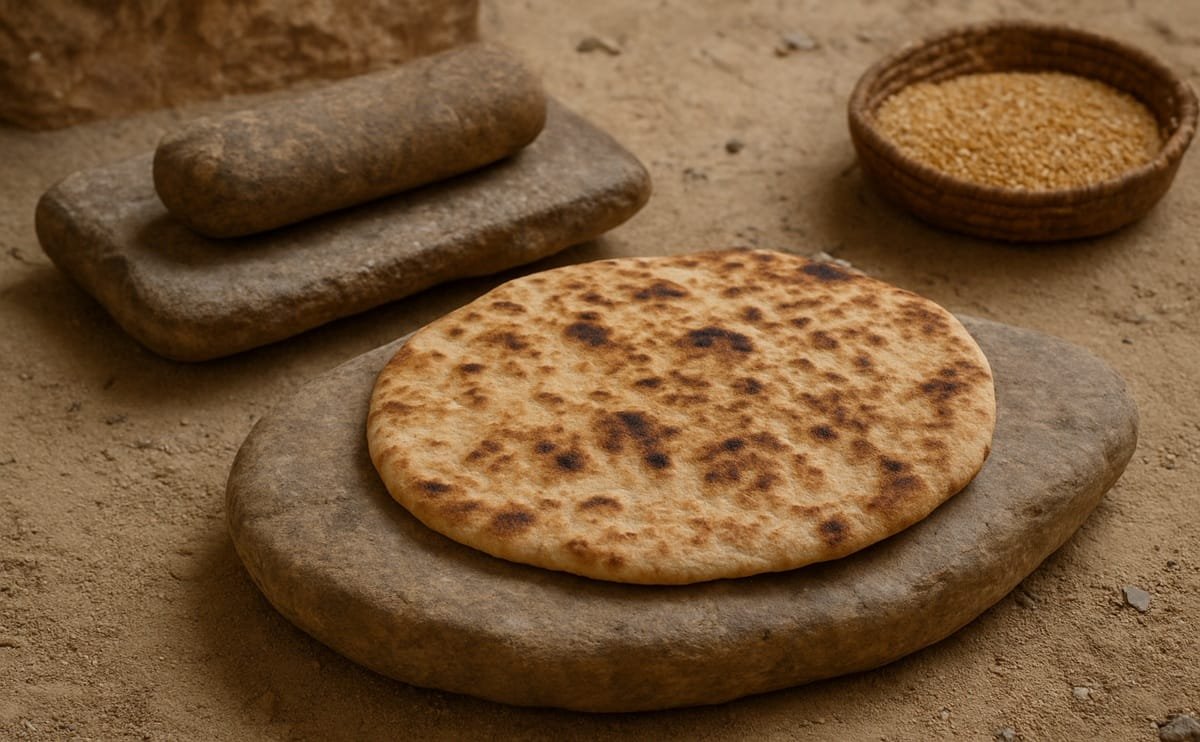The Oldest Food in the World: Ancient Flatbread from 14,000 Years Ago

This is a visual representation of how ancient flatbread looked over 14,000 years ago
Introduction
What is the oldest food in the world? Surprisingly, it’s something still found on our tables today—flatbread. Archaeologists discovered charred remains of flatbread over 14,000 years old in Shubayqa 1, an ancient site in northeastern Jordan. This bread predates agriculture, making it the earliest known processed food in human history.
What Was This Ancient Flatbread Made Of?
Long before cultivated wheat existed, humans used wild grains, barley, club-rush tubers, and sometimes even wild mustard seeds to make dough.
The basic ingredients were:
• Crushed wild grains
• Water
• Occasionally herbs for flavor
The dough was flattened by hand and quickly cooked. No yeast, sugar, or fat was used. It was simple—but revolutionary.
How Did They Toast the Flatbread Without Ovens?
You might wonder: without ovens, how did they get that toasty, golden surface?
1. On Hot Stones
The most common method was placing the dough on flat stones heated in fire. The intense surface heat toasted the underside while the top cooked in ambient warmth.
2. Directly in Ash or Coals
Sometimes the dough was placed directly onto embers or hot ash. After baking, the bread was brushed off to remove ash—a method still seen in some rural traditions.
3. Earth Pit Baking
A pit was dug, filled with firewood and stones. After heating, the dough was laid inside and covered with hot ash or leaves. The earth’s insulation slow-cooked and toasted the bread.
Note: These techniques gave the bread a smoky, charred texture that modern bakers often try to replicate.
Why Is This Discovery So Important?
• Pre-agricultural: Shows people were processing food long before farming.
• Cultural evolution: Suggests early humans valued convenience, flavor, and food storage.
• Technological innovation: Making and toasting bread without ovens or pots was a breakthrough.
Flatbread Across Cultures
Flatbread never disappeared—it evolved globally:
• Middle East: Lavash, pita, sangak
• India: Roti, chapati
• Mexico: Tortilla
• Europe: Focaccia, matzah
Its longevity shows how powerful and adaptable this ancient food is.
Myth or Truth? Did Ancient Gods Eat Bread?
Some ancient myths from Mesopotamia and Egypt describe deities receiving bread as offerings. While we can’t verify divine meals, we can verify that bread was central to ritual and survival in early civilizations.
This is where legend meets archaeology—but the bread is real.
Conclusion
From simple dough on hot stones to global staple, flatbread is more than food—it’s a symbol of survival, ingenuity, and shared human culture. The next time you eat a piece of flatbread, remember: you’re biting into 14,000 years of history.

